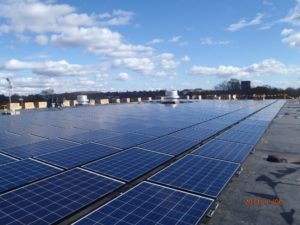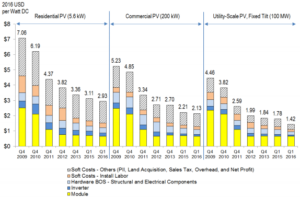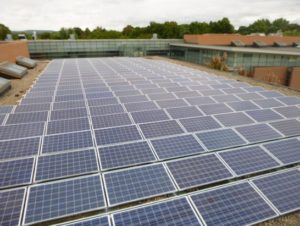- March 20, 2017
- 0 Comments
- In High-Performance Construction
- By Steven Winter Associates
Industry Trends
Over the past decade, the story of solar photovoltaic (PV) power has been one of both accelerating deployment and consistent, significant reductions in cost. This success has been driven by increasingly advantageous economies of scale, and supported by incentives and initiatives at all levels of government.
In late 2015, the federal Investment Tax Credit [3], a primary financial incentive for solar PV systems, was extended at its current rate of 30% through 2019, despite a contentious environment in Washington. It is scheduled to be stepped down through 2022, after which the commercial credit will expire and the residential credit [7] will remain at 10% indefinitely.
The National Renewable Energy Laboratory’s annual solar benchmarking report [4] shows that over the past seven years, PV system costs have dropped 58.5% in the residential sector, 59.3% in the commercial sector, and 68.2% in the utility-scale sector. As a clear sign of the times, utility-scale solar achieved the U.S. Department of Energy (DOE) SunShot Initiative’s goal of $1.00/W early this year, three years ahead of schedule [9]. According to the U.S. Energy Information Agency (EIA) [8], these trends should continue, leading to solar power’s increasing presence as a key component of the national electrical generation mix. The EIA projects solar to be the fastest growing form of renewable energy, increasing by 44% by the end of 2018 for a total deployed capacity of 31 GW and accounting for 1.4% of utility-scale electricity generation.
The trends of the solar market in New York are no different. Under the umbrella of the state’s Reforming the Energy Vision (REV) initiative, PV will be supported by incentive programs like NYSERDA’s NY-Sun rebate program and the forthcoming value of distributed energy resources (VDER) rate structure intended to replace net metering.
Additionally, solar requirements have already entered into New York State and City Energy Conservation Codes as an option for achieving compliance with the “Additional Efficiency Package” as well as additional provisions. With the overall positive solar industry trends, and solar’s strong support under REV, these code provisions are expected to remain, and solar will become an increasingly attractive method for achieving code compliance.
Commercial Code Provisions
Under the 2014 Energy Conservation Code [5], on-site renewable energy was listed as one of three options for Section ECC C406 – Additional Efficiency Package:
C406.1 Requirements
Buildings shall comply with at least one of the following:
- Efficiency HVAC Performance in accordance with Section C406.2.
- Efficient Lighting System in accordance with Section 406.3.
- On-Site Supply of Renewable Energy in accordance with Section C406.4.
Individual tenant spaces shall comply with either Section C406.2 or Section C406.3 unless documentation can be provided that demonstrates compliance with Section C406.4 for the entire building.
C406.4 On-site renewable energy
Total minimum ratings of on-site renewable energy systems shall comply with one of the following:
- Provide not less than 1.75 Btu (1850 W), or not less than 0.5 watts per square foot (5.4 W/m2) of conditioned floor area.
- Provide not less than 3 percent of the energy used within the building for building mechanical and service water heating equipment and lighting regulated in this chapter.
While there are myriad renewable technologies, solar is the only option that is economically viable at the commercial scale with any consistency. Therefore, if seeking to achieve compliance with ECC C406 using on-site renewable energy, a solar PV system is the best option.
An analysis of seven recent solar projects for new multifamily buildings that SWA was involved with showed that four of the projects met the minimum levels of PV power and energy generation, despite none of these projects intending to comply with ECC C406 using solar power. This indicates that with a little planning during the design and development phase of a project, achieving the standards set by ECC C406 should not be difficult for a multifamily building.
Under the 2016 Energy Conservation Code [6], the options for compliance with ECC C406 were expanded and altered slightly, but no changes were made to the on-site renewable energy option.
In addition to these provisions, there are a number of other energy code items that are potentially affected by installing a solar PV system. For projects pursuing compliance under ASHRAE [1,2], energy generated by on-site renewable energy sources can be deducted from the design energy cost, providing project teams with a greater amount of options for improving building energy performance. There are also a number of items in all versions of the code that allow exceptions if there is a solar PV system installed on the site, including:
- Roofing material solar reflectance and thermal emittance (2014 C402.2.1.1; 2016 C402.3)
- Energy recovery for ventilation systems (2014 C403.2.6; 2016 C403.2.7)
- Complex VAV systems serving multiple zones (2014 C403.4.5; 2016 C403.4.4)
- Service water heat recovery and equipment efficiency (2014 C403.4.6; 2016 C403.4.5, C404.2)
- Pool heating, controls, and covers (2014 C404.7; 2016 C404.9)
Residential Code Provisions
Additionally, a mandatory provision was added to the 2016 Energy Conservation Code [6] for solar-ready roof spaces for residential buildings, a strong indication that solar PV will continue to see strong support in future New York code revisions:
R401.4 Solar-ready requirements (Mandatory)
Detached one- and two-family dwellings and multiple single family dwellings (townhouses) shall meet the requirements of Appendix RB of this code.
The solar-ready zone requirements apply to new detached one- and two-family dwellings and townhouses with at least 600 ft2 of roof area oriented between 110° and 210° from true north. Buildings that have a permanently installed on-site renewable energy system and/or have shading on the solar-ready zone for more than 50% of annual daylight hours are exempt. The solar-ready zone requirements include:
- Minimum 100 ft2, exclusive of access or set-back pathways, for new townhouses less than four stories and with a total floor area less than or equal to 2,000 ft2 per dwelling
- Minimum 200 ft2, exclusive of access or set-back pathways, for all other new detached one- and two-family dwellings and townhouses
- Free from obstructions, including vents, chimneys, and roof-mounted equipment
- PV system included in structural calculations
- Pathway for solar conduit run
- Space reserved and labeled for electrical interconnection in main panel
For residential projects using the Energy Rating Index (ERI) pathway [6], it is not explicitly stated whether renewable energy, like solar PV, can or cannot be used to achieve code compliance like with ASHRAE. It is best to obtain approval from the local Authority Having Jurisdiction prior to the ERI analysis. When doing so, mention that the 2018 International Energy Conservation Code is expected to explicitly allow on-site renewable energy to be included for compliance.
Commissioning
If a solar PV system is installed, energy code also requires that commissioning be completed for the system, much like it has been previously required for mechanical and service water heating systems:
C408.2 Mechanical, renewable energy, and service water heating systems commissioning and completion requirements
Prior to passing the final mechanical and plumbing inspections, the approved agency shall provide evidence of mechanical systems commissioning and completion in accordance with the provisions of this section.
Construction document notes shall clearly indicate provisions for commissioning and completion requirements in accordance with this section and are permitted to refer to specifications for further requirements. Copies of all documentation shall be given to the owner or owner’s authorized agent and made available to the code official upon request in accordance with Sections C408.2.4 and C408.2.5.
Mechanical systems, renewable energy, and service water heating systems shall include but are not limited to, at a minimum, the following heating, ventilating, air conditioning, service water heating, indoor air quality and refrigeration systems (mechanical and/or passive) and associated controls:
- Heating, cooling, air handling and distribution, ventilation, and exhaust systems, and their related air quality monitoring systems.
- Air, water, and other energy recovery systems.
- Manual or automatic controls, whether local or remote, on energy using systems including but not limited to temperature controls, setback sequences, and occupancy based control, including energy management functions of the building management system.
- Plumbing, including insulation of piping and associated valves, domestic and process water pumping, and mixing systems.
- Mechanical heating systems and service water heating systems.
- Refrigeration systems.
- Renewable energy and energy storage systems.
- Other systems, equipment, and components that are used for heating, cooling, or ventilation and that affect energy use.
Exception:
- Mechanical and service hot water systems in buildings where the total mechanical equipment capacity being installed is less than 480,000 Btu/h (140.7 kW) cooling capacity and 600,000 Btu/h (175.8 kW) combined service water-heating and space-heating capacity.
- Renewable energy systems being installed with a generating capacity of less than 25kW.
Beyond this general requirement for commissioning to be completed, the energy code does not provide many specifics to help guide what exactly to do for commissioning a renewable energy system. At the very minimum, the commissioning plan for a solar PV system should include a visual inspection of all components, their condition, a comparison of the installed system to the designed system, and a comparison of actual and projected energy generation. A more in-depth inspection of the modules, conductors, and inverter controls may be necessary to ensure optimal system performance.
Conclusions
There are a variety of provisions in the energy code related to or affected by the installation of solar PV systems. Support for solar power in the code and through public initiatives are expected to continue to grow, particularly as the economic case for installing on-site renewable power improves. Financial incentives tied to installing solar power may have a finite life, but will still provide valuable support for several years.
The solar industry has seen tremendous change over the past decade and made huge strides in penetrating energy markets. Pursuing solar allows building owners to improve overall building energy performance, take advantage of incentives while they last, and develop familiarity with technology that will see sustained growth and support.
Steven Winter Associates is capable of providing a variety of services in order to guide building owners and project teams through the technical, financial, and regulatory challenges of solar power. SWA provides plan review, inspections, and commissioning for energy code compliance, solar feasibility studies, and a solar design-bid process intended to optimize a building for solar power and ensure the most cost-effective system is installed.
Works Cited
- ASHRAE, ANSI/ASHRAE Standard 90.1-2010. Energy Standard for Buildings Except Low-Rise Residential Buildings. 2010, American Society of Heating, Refrigerating, and Air-Conditioning Engineers, Inc.: Atlanta, GA.
- ASHRAE, ANSI/ASHRAE Standard 90.1-2013. Energy Standard for Buildings Except Low-Rise Residential Buildings. 2010, American Society of Heating, Refrigerating, and Air-Conditioning Engineers, Inc.: Atlanta, GA.
- “Business Energy Investment Tax Credit (ITC).” Database of State Incentives for Renewables & Efficiency. North Carolina Clean Energy Technology Center, 20 Feb. 2017. Web. <http://programs.dsireusa.org/system/program/detail/658>.
- Fu, Ran, Donald Chung, Travis Lowder, David Feldman, Kristen Ardani, and Robert Margolis. U.S. Solar Photovoltaic System Cost Benchmark: Q1 2016. Rep. National Renewable Energy Laboratory, 28 Sept. 2016. Web. <http://www.nrel.gov/docs/fy16osti/66532.pdf>.
- International Code Council. 2014 New York City Energy Conservation Code. 2014, New York, NY
- International Code Council. 2016 New York City Energy Conservation Code. 2016, New York, NY
- “Residential Renewable Energy Tax Credit.” Database of State Incentives for Renewables & Efficiency. North Carolina Clean Energy Technology Center, 14 Jan. 2016. Web. <http://programs.dsireusa.org/system/program/detail/1235>.
- Short-Term Energy Outlook March 2017. Rep. U.S. Energy Information Agency, 7 Mar. 2017. Web. <https://www.eia.gov/outlooks/steo/pdf/steo_full.pdf>.
- Wesoff, Eric. “SunShot $1 per Watt Solar Cost Goal: Mission Accomplished, Years Ahead of Schedule.” GreenTech Media. N.p., 25 Jan. 2017. Web. <https://www.greentechmedia.com/articles/read/Sunshot-1-Per-Watt-Solar-Cost-Goal-Mission-Accomplished-Years-Ahead-of-S>.
By Eric Wallace, Energy Engineer





